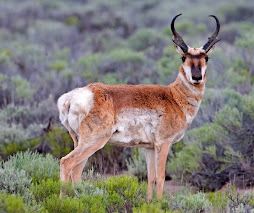Wedged between the great granite mountains and mesas in the southern region of North America lie the broad valleys of temperate desert ecology identified as the Sonoran Desert. Temperatures reach extreme daytime highs during the summer and extreme lows during winter. Evaporation of water exceeds precipitation, which is typically low and scattered supporting a dry landscape consisting primarily of sand with a few scattered rocks. The heat generated by the high daytime temperatures quickly escapes the ground at night radiating back into the atmosphere creating a cold nighttime environment.
Sonoran Pronghorn roam stable sand regions of the Sonoran Desert which contain a variety of desert grasses, forbs, cacti, and shrubs growing within the area or surrounding it. Pronghorn metabolize water obtained from the digestion of desert plants and drink from opportunistic water sources. The ability to generate metabolic water and to digest abrasive desert plants originates from the pronghorn’s ruminant or four-chamber stomach.
The food moves from the mouth to the rumen and reticulum where bile mixes with the plant substance to form cud. Symbiotic bacteria within the stomach contribute to the break down of the plant fibers. The pronghorn receives the regurgitated cud into the mouth and slowly chews it to further mix it with bile. The chewed cud passes through the rumen into the omasum. The omasum removes and stores the water. Pronghorn can go for extended periods of time utilizing the water stored by the omasum. The omasum processes the cud moving it into the abomasum. The abomasum moves the cud to the small intestine which absorbs the nutrients.
The smallest of the five subspecies, the Sonoran Pronghorn’s sturdy body sits on top of tapered slender legs. In spite of the fragile leg appearance, the Sonoran Pronghorn reaches speeds of 70 miles per hour and runs extended periods of time for 40 miles per hour making it the fastest land mammal in North America. Sonoran Pronghorn hooves consist of two long pointed toes designed to cushion the impact from running long distances.
Vision ranges on average from two to four miles away with eyes high on the sides of the head allowing a 300 degree view. Equivalent in size to an elephant, the eyes of the pronghorn dominate the species face. The combined vision and speed of the Sonoran Pronghorn remain the animal’s primary defense against bobcats, eagles, coyotes, humans and other predators.
The upper body of the Sonoran Pronghorn consists of light tan hair extending downward to the outer parts of the legs and upward over the head and nose. The under body, neck, inner legs and bottom of the head consist of white hair. Male pronghorn have a dark area of hair under each ear. The pronghorn stands patches of hair straight up to release body heat. The hair on the back hindquarters standing straight up combined with a sprayed scent serves to warn other pronghorn of predators.
Horns curve inward toward the pronghorn body with a forward projecting prong. Male horns contain a fork near the top and can grow up to 20 inches in length. If grown at all, female horns measure smaller in diameter than male horns. Giraffidae skin covers the base of the bone developing into a keratinous sheath to form the dark colored horn. Each season the horn becomes detached from the animals head to bud and grow again the following year.
Measuring approximately 3 feet tall from hoof to shoulder with a body length of approximately 4.3 to 4.8 feet from head to tail, the male pronghorn weigh approximately 100 to 130 pounds while female pronghorn weigh 75 to 100 pounds. The lifespan averages 10 to 12 years.
Mating season begins in late July extending to early October. Doe pronghorn begin to mate as early as 16 months, while bucks begin to mate at 12 months. Gestation lasts for approximately 210 to 225 days with twin fawns born in seasons offering abundant resources and one fawn in seasons of stress. Fawns continue to follow mothers through the first winter after becoming weaned at four months.
Phenology patterns vary throughout the year depending on the season. Pronghorn alternate periods of rest and foraging throughout the day and night with longer rest periods at night. Range consists of large areas based upon availability of food and water resources.
Monday, November 23, 2009
Subscribe to:
Post Comments (Atom)

No comments:
Post a Comment